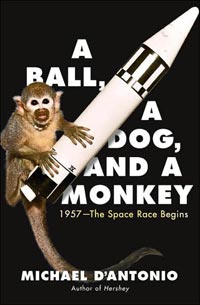|
|
Review: A Ball, A Dog, and A Monkey
by Jeff Foust
Monday, October 1, 2007
A Ball, A Dog, and A Monkey: 1957—The Space Race Begins
By Michael D’Antonio
Simon and Schuster, 2007
hardcover, 320 pp., illus.
ISBN 978-0-7432-9431-7
US$26
The modest level of public attention recently afforded to the birth of the Space Age, ranging from an occasional TV news piece to a special section of the New York Times’ ScienceTimes section last Tuesday, will reach a crescendo this Thursday on the 50th anniversary of the launch of Sputnik. Then, come October 5, that level of attention will effectively drop to zero as the media, new and old, turn their attention to other topics. One exception will be the bookstore, where a number of books whose publication was timed to the anniversary will live on, not subject to an expiration date like other media. One of those books is Michael D’Antonio’s A Ball, A Dog, and A Monkey, a book about the early history of the Space Age best suited for general audiences.
A Ball, A Dog, and A Monkey covers roughly the first year of the Space Age, from the launch of Sputnik in October 1957 through Project SCORE, which placed an entire Atlas booster in orbit with a small communications payload, including a tape-recorded message from President Eisenhower, just before Christmas 1958. The book examines both the Soviet and American programs, but places far more emphasis on the latter, from the political machinations in Washington to the technical difficulties of launching satellites to the effects the massive influx of space and missile workers had on the once-sleepy communities around Cape Canaveral. (The title itself refers to Sputnik, Laika, and a squirrel monkey named Gordo that the US launched on a suborbital spaceflight in late 1958.)
| The book does serve as a reminder that the history of that era is about not just about satellites and rockets, but also the people who created them or were touched by them in some way. |
With a story as well known as the opening of the Space Race, and one with few new revelations and insights, A Ball, A Dog, and A Monkey focuses primarily on stories from some of the people (primarily American) involved in that first year of the Space Age. Some of them are famous: Eisenhower, Wernher von Braun, and James Van Allen, the Iowa physicist whose experiments were flown on Explorer 1. Others are more obscure, yet still interesting. For example, there’s the story of Bradford Whipple, an airman assigned to a listening post in West Germany who was one of the first to detect the signals from Sputnik after its launch. The following summer, while on leave in Brussels to attend the world’s fair there, he is recruited by a mysterious American—presumably an intelligence agent of some sort—to stand guard outside the Soviet pavilion there one night while a group steals the Sputnik model on display there, returning it a couple hours later after studying it. Then there’s the case of the young man who managed a trailer park in Cocoa Beach that was home to many Cape workers: he discovered that some of their wives, lonely while their husbands worked long hours, could be particularly… hospitable.
These vignettes don’t provide a lot of new insights into how the beginning of the Space Age unfolded, but do liven up what would otherwise be a rather ordinary book about that era. A Ball, A Dog, and A Monkey is probably best suited for more general audiences, who have, at best, just a cursory knowledge about that era; space aficionados are unlikely to learn more beyond some of minor but entertaining tales involving spacecraft model heists and desperate aerospace housewives. (Moreover, one of the people profiled in the book, reporter Jay Barbree, has his own just-published book that covers that era from his perspective in greater detail.) A Ball, A Dog, and A Monkey does serve as a reminder, though, that the history of that era is about not just about satellites and rockets, but also the people who created them or were touched by them in some way.
Jeff Foust (jeff@thespacereview.com) is the editor and publisher of The Space Review. He also operates the Spacetoday.net web site and the Space Politics and Personal Spaceflight weblogs. Views and opinions expressed in this article are those of the author alone, and do not represent the official positions of any organization or company, including the Futron Corporation, the author’s employer.
|
|
